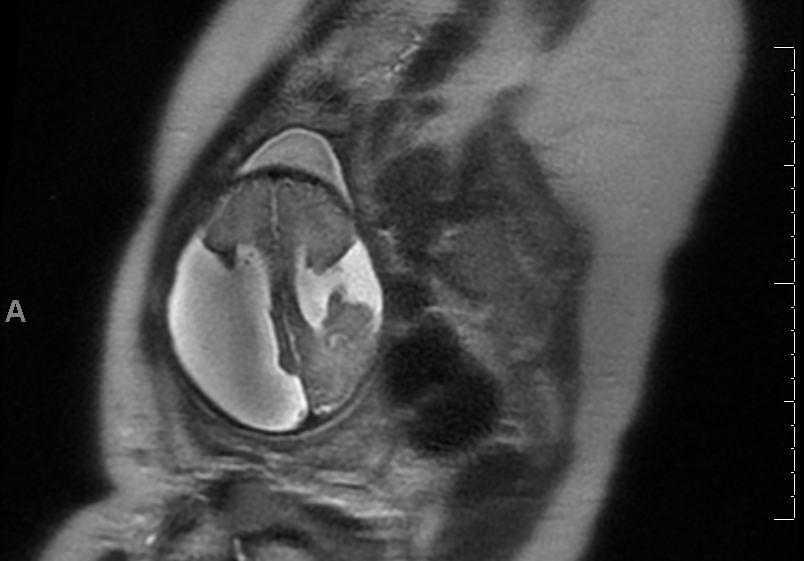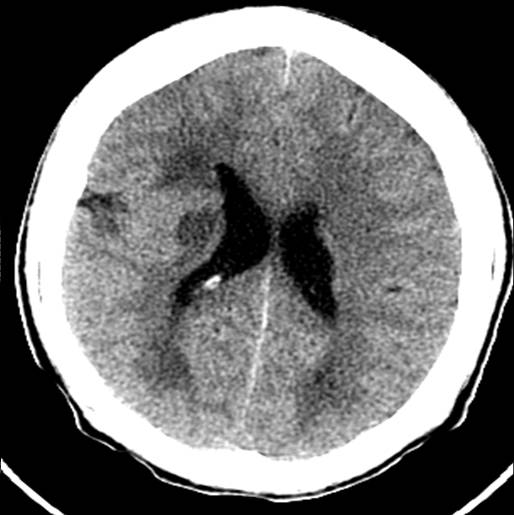[1]
Tanwir A, Bukhari S, Shamim MS. Frontoethmoidal encephalocele presenting in concert with schizencephaly. Surgical neurology international. 2018:9():246. doi: 10.4103/sni.sni_242_18. Epub 2018 Dec 4
[PubMed PMID: 30603230]
[2]
Hung PC, Wang HS, Chou ML, Lin KL, Hsieh MY, Chou IJ, Wong AM. Schizencephaly in children: A single medical center retrospective study. Pediatrics and neonatology. 2018 Dec:59(6):573-580. doi: 10.1016/j.pedneo.2018.01.009. Epub 2018 Jan 6
[PubMed PMID: 29371079]
Level 2 (mid-level) evidence
[3]
YAKOVLEV PI, WADSWORTH RC. Schizencephalies; a study of the congenital clefts in the cerebral mantle; clefts with fused lips. Journal of neuropathology and experimental neurology. 1946 Apr:5():116-30
[PubMed PMID: 21026933]
[4]
Howe DT, Rankin J, Draper ES. Schizencephaly prevalence, prenatal diagnosis and clues to etiology: a register-based study. Ultrasound in obstetrics & gynecology : the official journal of the International Society of Ultrasound in Obstetrics and Gynecology. 2012 Jan:39(1):75-82. doi: 10.1002/uog.9069. Epub 2011 Dec 5
[PubMed PMID: 21647999]
[5]
Griffiths PD. Schizencephaly revisited. Neuroradiology. 2018 Sep:60(9):945-960. doi: 10.1007/s00234-018-2056-7. Epub 2018 Jul 19
[PubMed PMID: 30027296]
[6]
Gonzalez JC, Singhapakdi K, Martino AM, Rimawi BH, Bhat R. Unilateral Open-lip Schizencephaly with Tonsillar Herniation in a Preterm Infant. Journal of pediatric neurosciences. 2019 Oct-Dec:14(4):225-227. doi: 10.4103/jpn.JPN_75_19. Epub 2019 Dec 3
[PubMed PMID: 31908665]
[7]
Dies KA, Bodell A, Hisama FM, Guo CY, Barry B, Chang BS, Barkovich AJ, Walsh CA. Schizencephaly: association with young maternal age, alcohol use, and lack of prenatal care. Journal of child neurology. 2013 Feb:28(2):198-203. doi: 10.1177/0883073812467850. Epub 2012 Dec 23
[PubMed PMID: 23266945]
[8]
Harada T, Uegaki T, Arata K, Tsunetou T, Taniguchi F, Harada T. Schizencephaly and Porencephaly Due to Fetal Intracranial Hemorrhage: A Report of Two Cases. Yonago acta medica. 2017 Dec:60(4):241-245. doi: 10.24563/yam.2017.12.005. Epub 2018 Feb 5
[PubMed PMID: 29434494]
Level 3 (low-level) evidence
[9]
Brunelli S, Faiella A, Capra V, Nigro V, Simeone A, Cama A, Boncinelli E. Germline mutations in the homeobox gene EMX2 in patients with severe schizencephaly. Nature genetics. 1996 Jan:12(1):94-6
[PubMed PMID: 8528262]
[10]
Hehr U, Pineda-Alvarez DE, Uyanik G, Hu P, Zhou N, Hehr A, Schell-Apacik C, Altus C, Daumer-Haas C, Meiner A, Steuernagel P, Roessler E, Winkler J, Muenke M. Heterozygous mutations in SIX3 and SHH are associated with schizencephaly and further expand the clinical spectrum of holoprosencephaly. Human genetics. 2010 Mar:127(5):555-61. doi: 10.1007/s00439-010-0797-4. Epub 2010 Feb 16
[PubMed PMID: 20157829]
[11]
Rege SV, Patil H. Bilateral giant open-lip schizencephaly: A rare case report. Journal of pediatric neurosciences. 2016 Apr-Jun:11(2):128-30. doi: 10.4103/1817-1745.187638. Epub
[PubMed PMID: 27606022]
Level 3 (low-level) evidence
[12]
Halabuda A, Klasa L, Kwiatkowski S, Wyrobek L, Milczarek O, Gergont A. Schizencephaly-diagnostics and clinical dilemmas. Child's nervous system : ChNS : official journal of the International Society for Pediatric Neurosurgery. 2015 Apr:31(4):551-6. doi: 10.1007/s00381-015-2638-1. Epub 2015 Feb 18
[PubMed PMID: 25690450]
[13]
YAKOVLEV PI,WADSWORTH RC, Schizencephalies; a study of the congenital clefts in the cerebral mantle; clefts with hydrocephalus and lips separated. Journal of neuropathology and experimental neurology. 1946 Jul
[PubMed PMID: 20993391]
[14]
Eller KM, Kuller JA. Fetal porencephaly: a review of etiology, diagnosis, and prognosis. Obstetrical & gynecological survey. 1995 Sep:50(9):684-7
[PubMed PMID: 7478420]
Level 2 (mid-level) evidence
[15]
Raybaud C, Girard N, Lévrier O, Peretti-Viton P, Manera L, Farnarier P. Schizencephaly: correlation between the lobar topography of the cleft(s) and absence of the septum pellucidum. Child's nervous system : ChNS : official journal of the International Society for Pediatric Neurosurgery. 2001 Apr:17(4-5):217-22
[PubMed PMID: 11398940]
[16]
Denis D, Chateil JF, Brun M, Brissaud O, Lacombe D, Fontan D, Flurin V, Pedespan J. Schizencephaly: clinical and imaging features in 30 infantile cases. Brain & development. 2000 Dec:22(8):475-83
[PubMed PMID: 11111060]
Level 3 (low-level) evidence
[17]
Patwal R, Pai NM, Ganjekar S, Arshad F, Alladi S, Sharma MK, Desai G, Chaturvedi SK. Schizencephaly and the Neurodevelopmental Model of Psychosis. Neurology India. 2022 Mar-Apr:70(2):740-743. doi: 10.4103/0028-3886.344662. Epub
[PubMed PMID: 35532651]
[18]
Kamble V, Lahoti AM, Dhok A, Taori A, Pajnigara N. A rare case of schizencephaly in an adult with late presentation. Journal of family medicine and primary care. 2017 Apr-Jun:6(2):450-452. doi: 10.4103/jfmpc.jfmpc_43_17. Epub
[PubMed PMID: 29302567]
Level 3 (low-level) evidence
[19]
Yoon JY, Kim DS, Kim GW, Ko MH, Seo JH, Won YH, Park SH. Motor Organization in Schizencephaly: Outcomes of Transcranial Magnetic Stimulation and Diffusion Tensor Imaging of Motor Tract Projections Correlate with the Different Domains of Hand Function. BioMed research international. 2021:2021():9956609. doi: 10.1155/2021/9956609. Epub 2021 Sep 6
[PubMed PMID: 34527746]
[20]
Rios LT, Araujo Júnior E, Nardozza LM, Caetano AC, Moron AF, Martins Mda G. Prenatal and Postnatal Schizencephaly Findings by 2D and 3D Ultrasound: Pictorial Essay. Journal of clinical imaging science. 2012:2():30. doi: 10.4103/2156-7514.96546. Epub 2012 May 23
[PubMed PMID: 22754744]
[21]
Bhatnagar S, Kuber R, Shah D, Kulkarni V. Unilateral closed lip schizencephaly with septo-optic dysplasia. Annals of medical and health sciences research. 2014 Mar:4(2):283-5. doi: 10.4103/2141-9248.129065. Epub
[PubMed PMID: 24761255]
[22]
Watanabe J, Okamoto K, Ohashi T, Natsumeda M, Hasegawa H, Oishi M, Miyatake S, Matsumoto N, Fujii Y. Malignant Hyperthermia and Cerebral Venous Sinus Thrombosis After Ventriculoperitoneal Shunt in Infant with Schizencephaly and COL4A1 Mutation. World neurosurgery. 2019 Jul:127():446-450. doi: 10.1016/j.wneu.2019.04.156. Epub 2019 Apr 25
[PubMed PMID: 31029817]
[23]
Senol U, Karaali K, Aktekin B, Yilmaz S, Sindel T. Dizygotic twins with schizencephaly and focal cortical dysplasia. AJNR. American journal of neuroradiology. 2000 Sep:21(8):1520-1
[PubMed PMID: 11003289]
[24]
Kim HJ, Koo YS, Yum MS, Ko TS, Lee SA. Cleft size and type are associated with development of epilepsy and poor seizure control in patients with schizencephaly. Seizure. 2022 May:98():95-100. doi: 10.1016/j.seizure.2022.04.002. Epub 2022 Apr 6
[PubMed PMID: 35462301]
[25]
Şah O, Türkdoğan D, Küçük S, Takış G, Asadov R, Öztürk G, Ünver O, Ekinci G. Neurodevelopmental Findings and Epilepsy in Malformations of Cortical Development. Turkish archives of pediatrics. 2021 Jul:56(4):356-365. doi: 10.5152/TurkArchPediatr.2021.20148. Epub 2021 Jul 1
[PubMed PMID: 35005731]
[26]
Park SH, Kim TJ, Ko SB. Super-refractory status epilepticus in a pregnant woman with schizencephaly. Epileptic disorders : international epilepsy journal with videotape. 2021 Jun 1:23(3):523-526. doi: 10.1684/epd.2021.1286. Epub
[PubMed PMID: 34080976]
[27]
Jordan RD, Coscia M, Lantz P, Harrison W. Sudden Unexpected Death in Epilepsy: A Report of Three Commonly Encountered Anatomic Findings in the Forensic Setting With Recommendations for Best Practices. The American journal of forensic medicine and pathology. 2022 Sep 1:43(3):259-262. doi: 10.1097/PAF.0000000000000773. Epub 2022 May 28
[PubMed PMID: 35642769]
[28]
Battah A, DaCosta TR, Shanker E, Dacosta TJ, Farouji I. Schizencephaly as an Unusual Cause of Adult-Onset Epilepsy: A Case Report. Cureus. 2022 Jun:14(6):e25848. doi: 10.7759/cureus.25848. Epub 2022 Jun 11
[PubMed PMID: 35836438]
Level 3 (low-level) evidence


